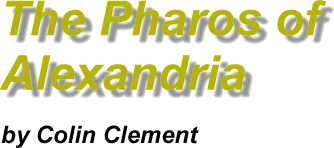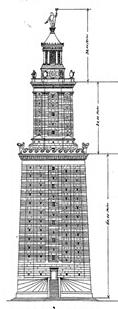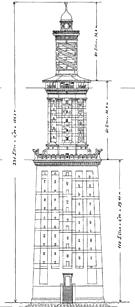Literary references

There is a story reported by Plutarch in his Life Of Alexander, which says that the conqueror, being so taken by Egypt decided to found:

"a large and populous Greek city which should bear his name, and by the advice of his architects was on the point of measuring off and enclosing a certain site for it. Then, in the night, as he lay asleep, he saw a wonderful vision. A man with very hoary locks and of a venerable aspect appeared to stand by his side and recite these verses:-
'Now there is an island in the much-dashing sea,
In front of Egypt; Pharos is what men call it.' "
Alexander knew his Homer and these brief lines were enough to call to mind the long passage from Book IV of The Odyssey where Menelaus tells Telemachus how he was stranded on the shores of Egypt. The island, Menelaus made clear, offered a good harbour where one could pull ships up onto the shore and take on water. So, continues Plutarch, the Macedonian set himself before the isle of Pharos and judging the situation to be very suitable "he said he saw that Homer was not only admirable in other ways, but also a very wise architect, and ordered the plan of the city to be drawn in conformity with this site."
Alexander did not stay long enough to witness the construction of the city and could not have known that the little island of Pharos would be the site of and give its name to the seventh Wonder of the World.

Construction of the Lighthouse was most probably begun under Ptolemy Soter, a general in Alexander's army who took control of Egypt after the wars of succession, and it was inaugurated by his son, Ptolemy Philadelphus, around 285 BC. It is generally reckoned that the Lighthouse was a tower over 100 metres tall standing on the eastern tip of Pharos island and that it was constructed in three stages: the first was square, the second octagonal and the last circular. Access to the entrance was up a long vaulted ramp. From there, a spiral staircase led up to the many chambers and it was perhaps used by beasts of burden to carry fuel to the third storey where the fire burned on the summit.
The graphic reconstruction that has remained the accepted popular view of the Lighthouse to this day was eleborated by Herman Thiersch, a German who wrote a large work entitled Pharos that has served as a standard reference since it was published in 1909. Thiersch studied images from coins, terracottas, and Roman mosaics in Libya and Jordan. He also had recourse to a wall mosaic in Saint Mark's at Venice which carries an image of the Lighthouse and he even undertook a study of various minarets in Egypt which are thought to have copied the form of the Lighthouse.
However, despite the good number of images that relate to the Lighthouse none is particularly precise and it is unfortunate that ancient writers have left few detailed descriptions. Although Arab voyagers are more forthcoming their reports must be taken with a pinch of salt as they tend to mix the fantastic with the seemingly most exact detail. A manuscript discovered in the first quarter of this century by one Abu el Haggag el Andalousi and dating from the 12th century contains measurements which might allow for graphic reconstructions of the tower but these would be at odds with the work of Thiersch to whom this source was unknown.

All in all there is still much that is uncertain about the form and very functioning of the Pharos. If the beacon on the summit was a simple wood fire, then how was a constant source of fuel provided in a land with so few trees? What is to be made of talk of mirrors or giant lenses that extended the visibility of the light? Furthermore, ancient texts regularly mention a statue as standing on the top of the tower, but if this was placed above a perpetually burning fire it would surely crack. Indeed, there is a debate as to whom this statue represented. For long it was supposed to be Poseidon, god of the seas, but later scholarship has opted for Zeus. Then again others have suggested that there were two statues; of Castor and Pollux. This theory is based upon the dedicatory inscription that was carved into the wall of the Lighthouse. It read:
"Sostratus of Cnidos, son of Dexiphanes, on behalf of mariners, to the Divine Saviours".While the formula "Divine Saviours" habitually refered to the twin sons of Zeus, Castor and Pollux, there may have been a deliberate ambiguity to allow reference also to Ptolemy Soter (saviour) and his wife Berenice, now both dead and deified. This Sostratus, who made the dedication, has often been taken for the architect of the Lighthouse, though it might be more accurate to see him as the entrepreneur who assured the construction.
Our uncertainty as to the exact form of the Lighthouse is all the more surprising in that there can be few monuments that have stood for so long fulfilling the same function as it once did. For seventeen centuries from its construction in 285 BC to its final destruction in the mid-14th century of our era it served as a guide to seafarers approaching the coast of Egypt. The fact that it survived all these years given its exposed situation - winter storms can be violent at Alexandria - clearly suggests that we are talking about a building of exceptional quality. It was, in fact, only earthquakes that could really touch the Lighthouse and there were plenty of them over the centuries.
 Between 320 and 1303, there were twenty-two of sufficient strength to be noted by the classical and Arab writers. In 796, the Lighthouse lost its upper storey and 100 years later the sultan, Ibn Touloun (868-884), built a domed mosque on the summit. Between 950 and 956, cracks began to appear in the walls and the tower lost some twenty-two metres in height. In 1261 another earthquake struck and more masonry fell.
Between 320 and 1303, there were twenty-two of sufficient strength to be noted by the classical and Arab writers. In 796, the Lighthouse lost its upper storey and 100 years later the sultan, Ibn Touloun (868-884), built a domed mosque on the summit. Between 950 and 956, cracks began to appear in the walls and the tower lost some twenty-two metres in height. In 1261 another earthquake struck and more masonry fell.
Certainly, as an object of admiration on the part of the Arabs it also became an object of their care and there are several recorded instances of repairs being undertaken. In 1272, for example, the sultan, Salah el Din (Saladin), ordered certain restoration work. And so the Lighthouse survived into the 14th century.
On 8 August, 1303 a violent earthquake shook the eastern Mediterranean basin. The effects were felt in Greece, the Levant and in the Nile Delta. Alexandria was particularly badly hit. In fact, as Ibn Taghribardi wrote, "The princes in charge of religious foundations were for long occupied in repairing the damage inflicted upon schools, mosques and even the Lighthouse." It must have been pretty badly struck for the end was indeed nigh. In 1326, the Moroccan traveller, Ibn Battuta, passed through Alexandria for the first time and recorded that he climbed the ramp leading to the tower entrance. On his return to the city in 1349 this was no longer possible. The Lighthouse was in ruins. It remained thus for just over a century until the Mameluke sultan, Qaitbey, decided to construct a fort on the foundations and it is this fort which stands today.
Illustrations
1-3. Graphic reconstruction by Hermann Thiersch showing, from top to bottom,
his idea of the Pharos a) in its original form; b) after renovation in the
time of Sultan Ibn Touloun; c) after renovation in the Fatamid period.
These drawings are taken from Thiersch's study of 1909.
4. The engraving of the Qaitbay Fort, circa 1798, is taken from the Description de l'Egypte